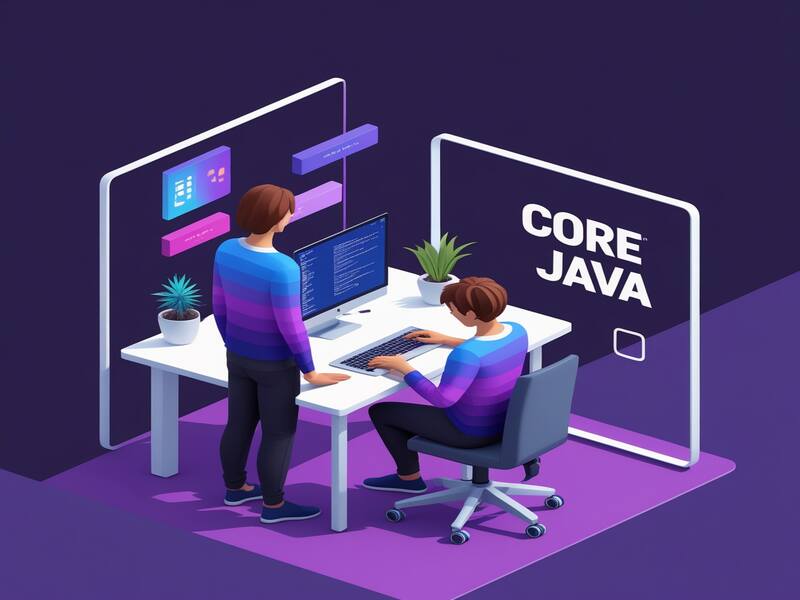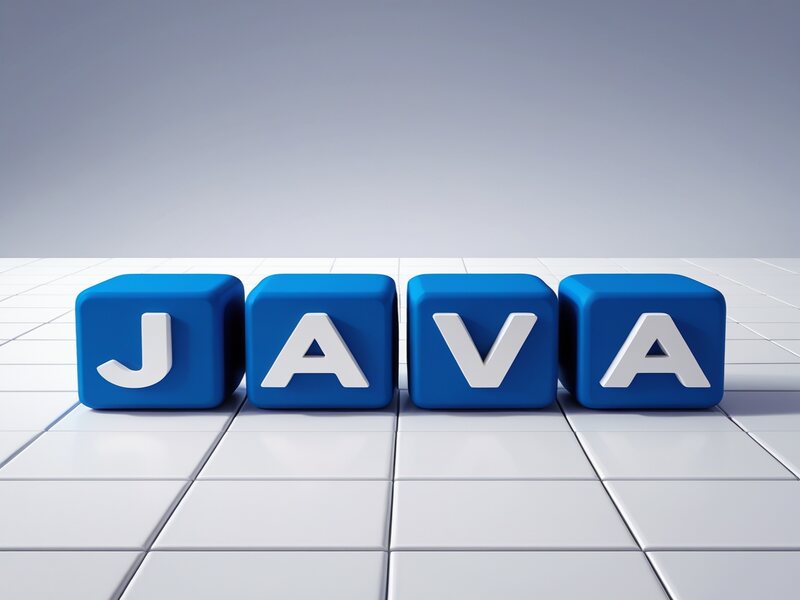Core Java Tutorial
Java is one of the world’s most widely used programming languages, known for its simplicity, portability, and scalability.
Core Java, the foundation of the Java language, focuses on the fundamental concepts and features that drive the language.
This blog will guide you through the key elements of Core Java, from its basic principles to its core features.

Introduction to Core Java
Core Java refers to the essential features and components that form the backbone of Java programming.
The foundational part of Java is used for developing general-purpose applications.
Unlike Java EE (Enterprise Edition), which deals with more advanced and specialised features like web development and enterprise-level applications, Core Java focuses on the basics, such as syntax, object-oriented programming (OOP), data structures, control statements, and more.
Core Java is a must-learn for every Java developer, as it forms the foundation for all other Java technologies.
Installation of Java
Install Java by following the instructions provided.
Set a path variable inside your environment variable.
Configure Eclipse by following the instructions provided.
Configure your Eclipse ID by moving it to your browser and typing “jdk”.(Java Development Kit)
Search for “Java” in your browser and click on the first link.
Click on the first link and be redirected to the official Oracle website.
Scroll down to find the version of Java and the operating system mentioned.
Install the version that suits your needs according to your system specification.
Select the x64 installer and click on the link to start downloading.
After the downloading is complete, move to your downloads folder.
Move to your PC local disk folder and locate the Java program files.
Inside the Java program files, find version you have installed.
Go inside the downloaded version and follow the instructions provided.
Key Features of Core Java
Platform Independence: One of Java’s primary benefits is its platform independence. Java applications are compiled into bytecode, which can run on any machine that has a Java Virtual Machine (JVM) installed.
This means that Java code can be executed across different platforms without modification.
Object-Oriented Programming (OOP): Java follows the object-oriented paradigm, where everything is treated as an object. This paradigm promotes reusability, scalability, and maintainability of code.
Java’s four main OOP principles—encapsulation, Inheritance, Polymorphism, and Abstraction—are essential for writing clean and modular code.

Robust and Secure: Java has a strong memory management system and error-checking capabilities. Its runtime environment checks for errors and exceptions, which makes it a reliable choice for large-scale applications.
Moreover, Java provides security features like running in a sandboxed environment, preventingunauthorised access to system resources.
Multithreading: Java’s ability to execute multiple threads simultaneously is another key feature.
This helps improve application performance, especially in environments that require concurrent processing, like financial applications or real-time systems.
Implicit vs Explicit
Implicit type conversion, also known as widening, is a process where the data type of a variable is automatically converted to a larger data type.
This can be done without any explicit type conversion or keywords.
On the other hand, explicit type conversion, also known as narrowing, requires the programmer to explicitly convert the data type of a variable to a smaller data type.
This is done using keywords such as (int), (float), etc.
Benefits of Executive Type Conversion
Executive type conversion is a useful tool in Java as it allows data to be stored within a shorter data range and then converted into a wider range without losing any data.
This is useful in situations where data needs to be stored in a smaller range and then processed or analyzed in a larger range.
Because the data stored in a lower range can fit inside a higher range, it ensures that the data is stored accurately and can be processed without any loss of information.

Core Java Tutorial Training

Working with Java: The Basic Components
To get started with Core Java, it’s essential to understand how Java code is structured and executed.
Java Development Kit (JDK)
To begin programming in Java, you need the Java Development Kit (JDK). The JDK provides the necessary tools to develop Java applications, including the Java compiler (javac) and the Java Runtime Environment (JRE) to execute the code.
The JDK also includes libraries and APIs that simplify the development process.

Java Compiler and JVM
When you write Java code, it is saved with the .java extension. The Java compiler (javac) compiles this source code into bytecode, which is saved in .class files.
This bytecode is platform-independent and can run on any machine with a JVM installed. The JVM is responsible for interpreting and executing the bytecode, interacting with the operating system and hardware, and ensuring that Java runs seamlessly across different platforms.
Core Java Concepts: A Deep Dive
Let’s take a closer look at some of the core concepts in Java:
Data Types and Variables
Understanding the various data types is crucial in Core Java. Java supports primitive data types (int, float, char, boolean) and reference data types (objects and arrays).
Variables store data in memory, and Java is strongly typed, meaning every variable must be declared with a specific type.
What are Variables, Constants, Keywords, and Separators in Java?
In Java, values are kept in constants and variables. To declare a constant, use the term “final” followed by “final”.
The variable’s data type is then declared using the “write final” line. The variable’s name and value are also supplied.
Values can be altered later in the program by establishing a variable called “result” or changing the result. These values can be stored in subsequent variables.
Keywords in Java are used to define functions and execute specific tasks. These restricted keywords cannot be used to define functionality or variable names.
Reserve keywords are not utilised to name variables or functions. They appear on the screen, such as “if for do double enum” and “if for do double enum”. These keywords will not be allowed in the program going forward.
Separators assist the Java compiler understand where the statement ends, making the code more readable.
Java Package Names and Main Functions
The importance of understanding the syntax and syntax of Java programming before executing the code.
The package name, which is the name of the project, is used to reference the package name and the project name.
The main function or class is of a public type, and the code execution starts from the main function or class.
The main class in Java is of a public type, meaning it cannot be changed or void. It is static and does not return anything. String args is used when trying to take input from the console string args.
To run a Java program, click on the run button and then select the desired file to run. Save the resource before launching the button to avoid saving again.
Control Statements
Control statements allow you to control the flow of your program. There are three types of control statements in Java:
Selection Statements: if, if-else, and switch are used to execute a code block based on certain conditions.
Iteration Statements: Loops like for, while, and do-while allow you to repeat a block of code multiple times.
Jump Statements: break and continue to control the loops and conditional statements flow.

Methods
Methods are blocks of code that perform a specific task. Java allows you to define methods that can be called from other parts of the program.
A method can take input (parameters), process it, and return a result (return value). Methods promote code reusability and modularity.
Arrays
Arrays are used to store multiple values in a single variable. Java supports both single-dimensional and multi-dimensional arrays.
Arrays are indexed, starting from zero, and can store values of any data type, including objects.

Core Java Tutorial Online Training

Object-Oriented Programming Principles in Core Java
As an object-oriented language, Java relies heavily on its four core OOP principles:
Encapsulation: This involves wrapping data (variables) and code (methods) together into a single unit known as a class.
Access to the data is controlled through getter and setter methods, ensuring that data is protected from unauthorised access.
Inheritance: Inheritance allows one class to inherit properties and behaviours from another. This enables code reuse and the creation of hierarchical relationships between classes.
For example, a Dog class can inherit from an Animal class.
Polymorphism: Polymorphism allows objects of different classes to be treated as objects of a common superclass. It enables a single interface for multiple forms, enhancing flexibility and scalability.
Abstraction: Abstraction hides the complex implementation details from the user and only exposes the essential features of an object. In Java, abstract classes and interfaces achieve this.
How do non-primitive data types contribute to Java programming?
Non-primitive data types in Java are user-defined data types that can be customized and created according to the user’s needs.
They include class objects, strings, arrays, and interfaces, and play a crucial role in organizing and structuring data in Java programs.
Their customization and reusability make them powerful tools for efficient and effective programming.
Creating an array in Eclipse?
In Eclipse, an array can be created using a name and square brackets to store the values. The values can be assigned inside the array by name, index, and number of elements.

Practical Applications of Core Java
Core Java is widely used across many domains. Some of the standard applications include:
Desktop Applications: A platform-independent nature, Java is often used to develop cross-platform desktop applications.
Mobile Development: Java is the primary language for Android development, allowing developers to build various mobile apps.
Web Development: Core Java is also used for server-side development with frameworks like Spring and Hibernate.
Embedded Systems: Java is used in embedded systems where performance and security are crucial.
Primitive data type and its functions
Primitive data types are predefined data types that are already given by Java programming. These data types have specific size and type, with eight being the most common.
In addition to the primitive data type, there are other types of data types, such as strings arrays and arrays.
These data types have specific sizes and types, which are determined by the language and the data type being defined.
Floating Point Data Storage
Floating Point data is used for data containing decimal values. There are two data types: float and double.
Floating Point data is 32bit and has an unlimited range. The default value of float is 0.0f, which takes 4 bytes of data.
Double data is also 64bitit double Precision, while floating Point data has an unlimited range. The default value of double is 0.0 d, which takes 8 bytes of space.
CurrencyData Storage
Currency is another type of storage, with double being 64bit I double Precision. Double is 64bit I double Precision.
Floating Point data has an unlimited range, and its default value is 0.0 d. The default value of double is 0.0 d, which takes 8 bytes of space.
Bullion Data Storage
Bullion is another type of storage that stores two values inside it. It mainly uses bullion when creating flags and tracking something.
Bullion is used when creating true and false flags, and it is used when creating flags to keep track of something. Initialize Bullion has a default value of false, which takes one bit of data space.
and then the CPU also has care functions, which store values in memory. These functions allow for easy access to data, but they should not be used for precise calculations or calculations.
Conclusion
Core Java is the foundation upon which all Java-based technologies are built. Developers can create various applications by understanding their basic features, principles, and tools, from mobile apps to large-scale enterprise solutions.
Whether you’re just starting or enhancing your existing Java skills, mastering Core Java is essential to your programming journey.
Understanding Core Java concepts like object-oriented programming, data types, control statements, and methods will improve your coding skills and lay the groundwork for working with more advanced Java technologies.

Core Java Tutorial Course Price


Saniya
Author